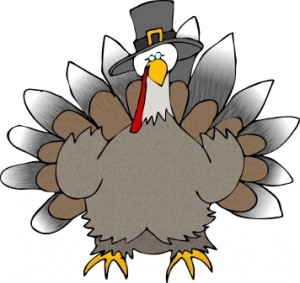Stuffing – most of us love it, eat it, go back for seconds (thirds?), and then eat the leftovers.
But did you ever really think about stuffing – like why it’s called stuffing (or dressing) and what makes it taste so good?
Ten Stuffing Tidbits
- There’s some difference of thought about stuffing vs. dressing. For a lot of people, stuffing is stuffing whether it’s cooked inside the bird or in a separate baking dish. Some people call stuffing the stuff that is stuffed into the bird and they call dressing the stuff that is cooked separately, even if it’s made from the same recipe. Others go a bit further and maintain that dressing is pourable therefore stuffing is stuffing regardless of how or where it’s cooked. People in different parts of the country favor different terms. The Amish often call it filling.
- Although there are some historical references about the use of stuffing in Ancient Italy, according to Bonappétit.com, stuffing comes from “farce,” which is the word for stuffing in French. In the 16th century, the term “stuffing” replaced farce. Farce, the stuffing and farce, the form of comedy, both started out as the Latin farcire, which means “to stuff.” The farce made to be eaten was a filler for a roast. Initially, the theatrical farce was a theatrical improvisational padding of French religious dramas and the actors, for laughs, were expected to ham it up.
- Semantics! Cookbook authors favored “dressing,” in the 19th century, but used stuffing and dressing interchangeably or wrote recipes that called for cooked birds with the dressing stuffed inside.
- In 1972 when Stove Top introduced an instant stuffing mix that could be made without the bird, was cooked on top of the stove, and was cheap and easy to make, “stuffing” became the go to word.
- Stove Top sells 60 million boxes of stuffing every Thanksgiving. When prepared according to box directions and with no additional additives, a ½ serving has: 105 calories, 4.2g fat, 14.7g carbs, 336mg sodium, 2.1g protein.
- Stuffing is a seasoned mix of vegetables and starches and sometimes eggs or other protein. Stuffing recipes vary regionally. Southerners usually use cornbread while people from other parts of the country generally use white or wheat bread as the base. Often celery or other vegetables, chestnuts, apples, cranberries, raising, oyster, sausage, turkey giblets, sage, onion, or pecans can be added.
- Stuffing is extremely porous. If it is “stuffed” into a turkey, as the turkey cooks the turkey juices that may contain salmonella get into the stuffing. To be safe and prevent salmonella problems, the stuffing must be heated to 165 degrees Farenheit. Cooking the stuffing to 165 degrees usually means the turkey will be overcooked and dry.
- If you’re putting the stuffing in the turkey, do it just before roasting – not the night before — so the juices with possible salmonella don’t have all night to soak into the stuffing. Allow 1/2 to 3/4 cup of stuffing per pound and don’t pack it in too tightly which might cause uneven cooking and not all of the stuffing reaching 165 degrees.
- If you’re cooking your turkey on an outdoor grill, or in a water smoker, or you’re using a fast-cook method, don’t stuff it because the turkey will be done before the stuffing reaches 165 degrees.
- There’s no historical evidence that stuffing was served at the first Thanksgiving. Stuffing is really thought of mainly as a Thanksgiving food. Before the advent of Stove Top many home cooks wouldn’t have made stuffing for the holidays. Stove Top, cheap, quick and easy helped stuffing become very popular.
If you’re beginning to get antsy about holiday eating, download my book, The Sensible Holiday Eating Guide: How To Enjoy Your Favorite Foods Without Gaining Weight, http://www.amazon.com/dp/B009VOFIK8 on Amazon.
Then sign up for a free ½ hour teleseminar on Thanksgiving Eating: Challenges and Solutions, https://eatouteatwell.com/thanksgiving-teleseminar-signup. It’ll be recorded if you can’t make it, but you still need to sign up so I know where to email the link to the recording.


What a fun post, Penny! Being from the South, I thought I knew all about stuffing.
For my taste, I actually do not like cornbread in mine, just white or wheat bread. Today, I look for bread that is a higher protein count.
My favorite stuffing includes: celery, onions, raisins, carrots, and several raw eggs to moisten the mixture, which increases the protein. I use chicken stock rather than water. My stuffing is more moist than most before it goes into pans.
I also like to use loaf pans for the stuffing, which makes it even moister after it is baked.
Thanks for this fun diversion, Penny!
Donna Blevins
Poker MindSet Coach
Thanks, Donna. I love stuffing, too — I make mine with onions, celery, chicken stock, pecans, rosemary, and butter. My family favors savory rather than sweet and my sons won’t touch food with raisins in it (but they’ll eat raisins alone). I do cook my stuffing in pans, not in the turkey. To me, turkey means stuffing. It’s Thanksgiving and turkey time and everyone who loves stuffing should eat it and enjoy it. (Maybe lay off the seconds and thirds!) Good tip about the higher protein bread — something to try.